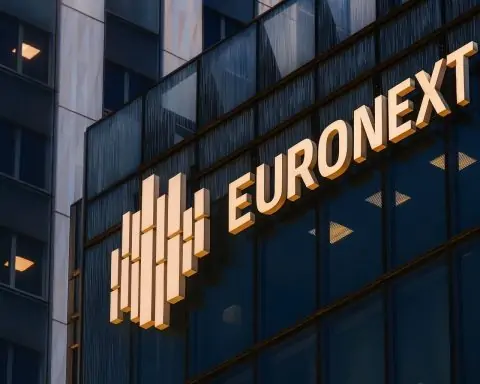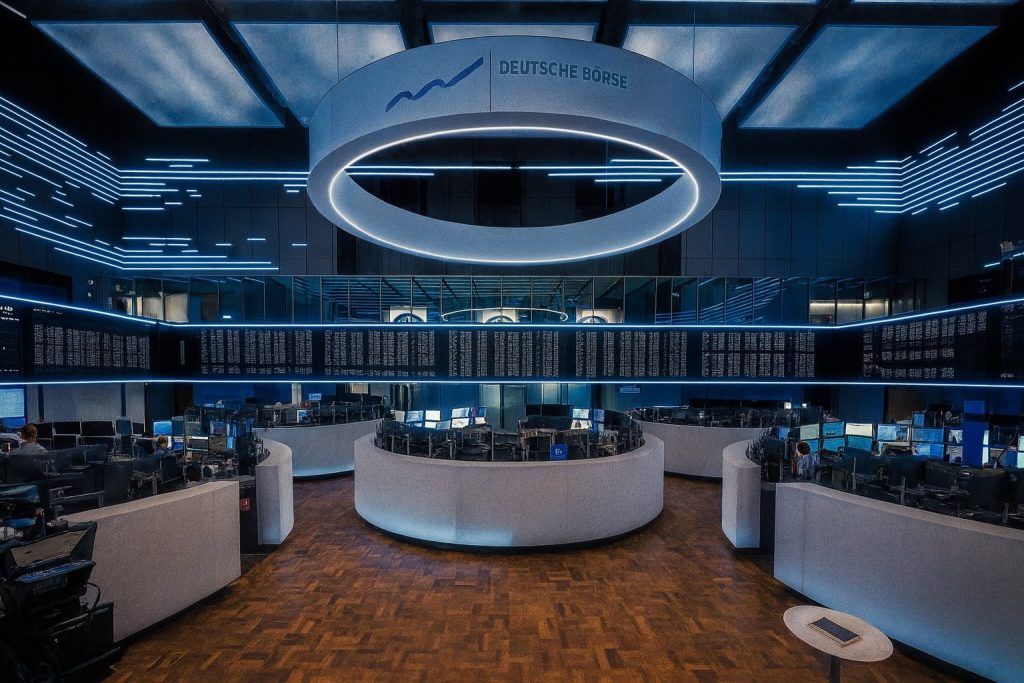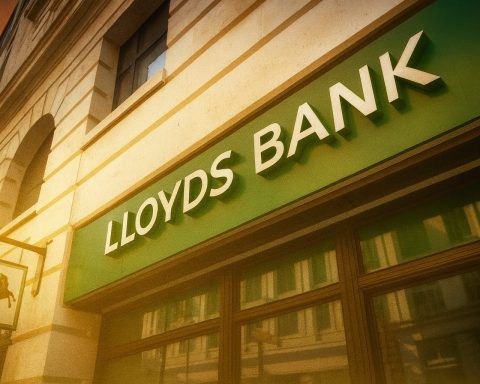The UK stock market was trying to find its footing on Wednesday 19 November 2025, as investors weighed cooler inflation data, a weaker pound and a flurry of corporate news led by WH Smith’s shock chief executive exit.
By late morning, the FTSE 100 had recovered early losses to trade modestly higher, up about 0.1% at 9,565.99 as of 10:35 GMT, after falling 1.3% in Tuesday’s global sell-off. [1] The mid‑cap FTSE 250, which had also been hit hard the previous session, was only fractionally higher, reflecting lingering caution after a volatile few days. [2]
Key points at a glance
- FTSE 100: Down around 0.2% shortly after the open, then edging into positive territory by late morning near 9,566. [3]
- UK inflation: CPI fell to 3.6% in October (from 3.8%), the first drop in five months and broadly in line with forecasts, boosting hopes of a Bank of England rate cut in December. [4]
- Currency & bonds: The pound slipped to around $1.31 and gilt yields eased as traders priced in a slightly faster pace of future rate cuts. [5]
- Corporate movers:
- WH Smith sinks after its CEO resigns over accounting failures in North America. [6]
- Smiths Group launches a £1bn share buyback alongside Q1 growth. [7]
- Jet2 reports another set of record interim results. [8]
- Severn Trent posts a sharp profit jump but announces CEO Liv Garfield will step down. [9]
- Workspace and British Land results keep UK commercial property in focus. [10]
- Regulation: The FCA confirms a UK equity “consolidated tape” should go live by 2027, aiming to improve transparency in stock trading. [11]
Market snapshot: FTSE 100 claws back from Tuesday’s rout
Wednesday’s session opened on a cautious note. At 08:54 GMT the FTSE 100 was down about 0.2%, extending Tuesday’s slump that had knocked the index 1.3% lower and dragged the FTSE 250 down 1.2%. [12]
However, as traders digested the latest inflation figures and reassessed the odds of a December rate cut, buyers slowly returned. By 10:35 GMT, the FTSE 100 had nudged into the green, up 0.14% at 9,565.99, leaving it still well below last week’s record intraday high near 9,930 but comfortably above April’s lows. [13]
The move followed a bruising global sell‑off on Tuesday, when concerns over stretched AI-related valuations, fading expectations of a near‑term US Federal Reserve cut and nerves ahead of Nvidia’s earnings hit risk appetite worldwide. [14] European indices remained subdued on Wednesday, with the pan‑European STOXX 600 hovering near a one‑month low and tech stocks under pressure. [15]
Mid‑caps were steadier. Early commentary suggested the FTSE 250 was up only about 10 points, a near‑flat move that underlined how fragile sentiment remains after several days of declines. [16]
Inflation dips to 3.6% – and markets lean toward a December BoE cut
The main macro catalyst for UK markets on 19 November was the Office for National Statistics’ October inflation release.
Headline CPI slowed to 3.6% year‑on‑year, down from 3.8% in September – the first decline since May and very close to economist expectations. [17]
Key details from the data:
- Core inflation (excluding food and energy) eased from 3.5% to 3.4%. [18]
- Services inflation, closely watched by the Bank of England, fell more than expected to 4.5%, its lowest level since December 2024. [19]
- The biggest downward pressure came from energy and housing‑related costs, as gas and electricity bills rose more slowly following changes to Ofgem’s price cap. [20]
- Food and drink inflation moved the other way, rising to 4.9%, with staples such as bread, cereals and meat still exerting pressure on household budgets. [21]
Markets quickly translated the release into interest‑rate bets:
- The pound slipped around 0.2% to $1.31, while two‑year gilt yields moved lower as traders priced in a slightly more aggressive path of future rate cuts. [22]
- Futures markets now see a high probability that the BoE cuts Bank Rate from 4% to about 3.75% at its December meeting, with additional easing expected through 2026. [23]
Economists quoted in official and media commentary argue that with inflation on a “sustained downward path” and growth indicators cooling, the ingredients are in place for a cut – although a tight 5–4 vote to hold rates in November shows the Monetary Policy Committee is still divided. [24]
For equity investors, lower inflation and the prospect of cheaper money are broadly supportive. But the fact that UK inflation is still the highest in the G7, combined with looming fiscal decisions in next week’s 26 November budget, is keeping volatility elevated in both stocks and sterling. [25]
WH Smith tumbles after CEO quits over US accounting failure
The most dramatic single‑stock story on the day came from WH Smith, the travel‑focused retailer and FTSE 250 constituent.
The company announced that CEO Carl Cowling has resigned with immediate effect after an independent review by Deloitte uncovered accounting failures in its North American division. [26]
According to the findings:
- The US travel retail arm had been recognising “supplier income” earlier than it should, forcing WH Smith to defer about £20m of revenue. [27]
- The company cut its 2025 profit guidance, saying group headline trading profit is now expected to fall to £100m–£110m, almost half last year’s level. North American profit is now seen at £5m–£15m, down sharply from the previous £25m forecast. [28]
- Chair Annette Court said the board “sincerely apologised” for the shortcomings and pledged to rebuild trust and strengthen financial controls in the US business. [29]
Andrew Harrison, head of WH Smith’s UK operations, has been appointed interim CEO while the board searches for a permanent replacement. [30]
Shares in WH Smith fell about 2% in early trading, extending a slump that has already wiped roughly 47% off the share price since the accounting issues first surfaced in August. [31]
The episode is another blow to investor confidence in UK‑listed corporates after a string of governance‑related headlines this year, and is likely to keep WH Smith under intense scrutiny from both regulators and the market.
Smiths Group, Jet2 and British Land offer brighter corporate news
Not all company updates were negative. Several high‑profile names delivered results that investors broadly welcomed, even if wider risk‑off sentiment limited gains.
Smiths Group: £1bn buyback and solid Q1
Engineering group Smiths Group reported 3.5% organic revenue growth in the quarter to 31 October, driven in part by strong performance at its Smiths Detection unit. [32]
More eye‑catching was the capital allocation announcement:
- The group plans a new £1bn share buyback, funded largely by the sale of its Smiths Interconnect business to Molex, on top of an existing £500m programme that is due to complete in December. [33]
- Management reaffirmed guidance for the 2026 financial year as it continues to reposition Smiths toward higher‑margin industrial technologies. [34]
The stock traded moderately higher, with investors cheering the continued streamlining of the portfolio and the promise of additional cash returns, even against a choppy macro backdrop.
Jet2: another set of record interim results
Leisure airline and tour operator Jet2 delivered another strong set of interim numbers for the half‑year to 30 September:
- Revenue rose 5% to £5.34bn.
- Operating profit edged up 2% to £715.2m.
- Profit before tax climbed to £800.3m, with statutory profit after tax at £600.2m. [35]
Management highlighted record passenger numbers, revenue and profitability despite a “volatile, late‑booking” market, and kept the full‑year outlook on track. [36]
While Jet2’s share price has already enjoyed a strong run over the past year, today’s update reinforced the company’s reputation as one of the UK market’s more dependable travel names.
British Land: higher rents support profit growth
Real estate group British Land also reported resilient figures:
- Underlying profit for the six months to 30 September rose about 8% to £155m, helped by higher rents and solid occupancy across London office campuses and retail parks. [37]
- The company nudged its dividend up 1% and guided for around 5% like‑for‑like rental growth in the 2026 financial year, with underlying EPS growth of at least 6%. [38]
The update reinforces the theme that prime, well‑located UK commercial property continues to hold up better than more leveraged, secondary assets—important context for investors scanning the FTSE 350 real‑estate names.
Utilities and offices in focus: Severn Trent and Workspace
Severn Trent: big profit jump, big leadership change
Water utility Severn Trent posted a striking set of half‑year numbers:
- Profit before interest and tax surged 56.5% to £466.2m, with revenue up 18% to £1.44bn in the six months to 30 September. [39]
Despite the strong financials, the headline was CEO Liv Garfield’s decision to step down after 11 years in the top job. She will be replaced in early 2026 by internal candidate James Jesic, currently capital & commercial services director and head of Welsh subsidiary Hafren Dyfrdwy. [40]
Investors appeared to take the succession news cautiously, with shares down around 1% in early trading even as the company boasted record investment and access to £900m of new debt at tight spreads. [41]
Workspace: flat rental income, pressure on valuations
London‑focused flexible office landlord Workspace Group released half‑year results that were “in line with expectations” but underlined the challenges facing UK commercial property:
- Underlying net rental income was flat at £58.6m, while trading profit after interest fell 6.4% to £30.6m. [42]
- EPRA net tangible assets slid 6.8% to £7.21 per share, reflecting a 3% like‑for‑like valuation drop.
- Like‑for‑like occupancy fell to 80%, and the rent roll declined 3.3%. [43]
The group held its interim dividend at 9.4p and stressed progress on its “Fix, Accelerate and Scale” strategy, but shares were under pressure as investors focused on falling capital values and softer occupancy trends. [44]
Structural shift: FCA’s equity ‘consolidated tape’ moves ahead
Beyond day‑to‑day price moves, Wednesday also brought important market‑structure news.
The Financial Conduct Authority announced that a new equities “consolidated tape”—a real‑time feed aggregating pre‑ and post‑trade data from UK trading venues—should be operational by 2027, with a consultation now underway on the detailed design. [45]
Key points:
- The tape aims to give investors and issuers a clearer view of liquidity across UK markets, addressing long‑standing complaints that fragmented trading makes it hard to see true prices and depth. [46]
- After two years of operation, the FCA will review whether to expand the amount of pre‑trade data included.
- Some industry voices, including large investment banks, welcome the move as “long‑needed transparency”, while the London Stock Exchange Group has questioned whether there is a strong use case for pre‑trade data given existing vendors. [47]
Although esoteric, the project could over time support liquidity and valuations in the UK equity market—an important consideration as policymakers try to make London more attractive for listings.
Big picture: edgy markets ahead of Reeves’s budget and Nvidia’s results
Even with today’s modest bounce, UK markets remain on edge.
A detailed Reuters analysis on Wednesday warned that the 26 November budget will be a “major test” for bonds, stocks and sterling, especially after reports that Chancellor Rachel Reeves may rule out income‑tax rises despite calls from investors for more robust fiscal consolidation. [48]
At the same time:
- UK assets are still digesting last week’s sell‑off, when the FTSE 100 and FTSE 250 both dropped more than 1% and high‑beta sectors such as banks and miners led declines. [49]
- Global risk sentiment hinges on Nvidia’s earnings, due after the US close, which are seen as a litmus test for the sustainability of the AI‑driven rally that has pushed tech valuations to extremes. [50]
For UK equity investors, that means:
- Short‑term volatility is likely to remain elevated, especially in cyclical sectors such as financials, housebuilders and discretionary retail, which are highly sensitive to both domestic fiscal decisions and global risk appetite. [51]
- Rate‑sensitive names—real estate, infrastructure and utilities—are caught between the positives of easing inflation and the negatives of regulatory and political scrutiny.
What to watch next
Over the coming days, traders and longer‑term investors alike will be focused on:
- Bank of England expectations
- Any further speeches from MPC members that either endorse or push back on the growing market conviction of a December rate cut. [52]
- Reeves’s first full budget on 26 November
- Details on tax, spending and borrowing plans will directly influence gilt yields, sterling, and rate expectations—and by extension equity valuations. [53]
- Nvidia and global tech sentiment
- A strong or weak outlook from the AI giant could sway European and UK indices, given the growing correlation between global risk assets and US mega‑cap tech. [54]
- Further corporate updates
- Follow‑through moves in WH Smith, Severn Trent, Jet2, Smiths Group, Workspace and British Land as investors fully digest today’s numbers and governance headlines.
For now, the message from 19 November is that the UK stock market is stabilising rather than roaring back—helped by softer inflation and pockets of strong corporate news, but still overshadowed by fiscal uncertainty and global tech‑driven volatility.
References
1. markets.ft.com, 2. www.ajbell.co.uk, 3. m.investing.com, 4. www.reuters.com, 5. m.investing.com, 6. www.reuters.com, 7. www.reuters.com, 8. www.investing.com, 9. ng.investing.com, 10. www.investing.com, 11. www.reuters.com, 12. m.investing.com, 13. markets.ft.com, 14. www.reuters.com, 15. www.reuters.com, 16. www.ajbell.co.uk, 17. www.reuters.com, 18. www.reuters.com, 19. www.reuters.com, 20. www.ons.gov.uk, 21. www.theguardian.com, 22. m.investing.com, 23. www.reuters.com, 24. www.reuters.com, 25. www.theguardian.com, 26. www.reuters.com, 27. www.reuters.com, 28. www.reuters.com, 29. www.reuters.com, 30. www.reuters.com, 31. www.reuters.com, 32. www.reuters.com, 33. www.reuters.com, 34. www.reuters.com, 35. www.investing.com, 36. www.investing.com, 37. m.investing.com, 38. www.investing.com, 39. ng.investing.com, 40. www.sharesmagazine.co.uk, 41. ng.investing.com, 42. www.investing.com, 43. www.marketscreener.com, 44. www.estatesgazette.co.uk, 45. www.reuters.com, 46. www.reuters.com, 47. www.reuters.com, 48. www.reuters.com, 49. www.reuters.com, 50. www.reuters.com, 51. www.reuters.com, 52. www.reuters.com, 53. www.reuters.com, 54. www.reuters.com









